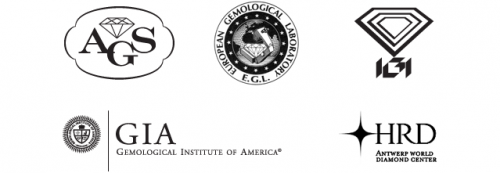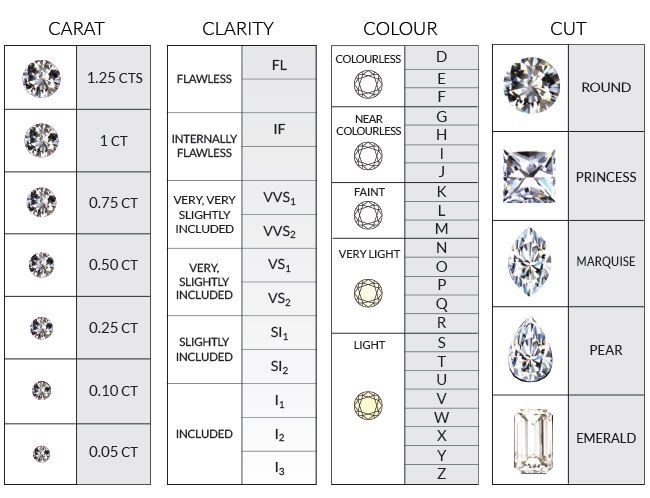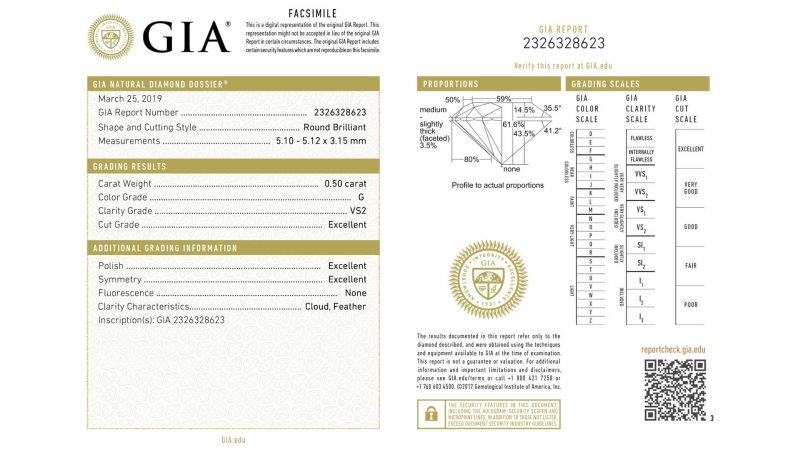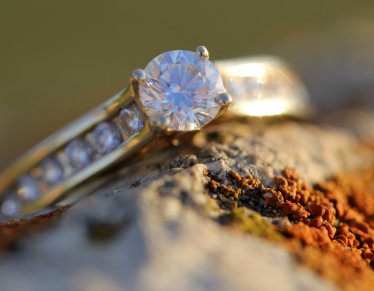Shopping for a diamond or a piece of jewelry that will contain a diamond (or multiple diamonds) is an exciting process, but it can feel a bit daunting when you are first getting started. You’ve likely heard lots of reports about people getting ripped off, ending up with imperfect quality diamonds, or even fake or conflict-free diamonds.
You certainly don’t want that! The good news it, there is a process put in place to help prevent anything like that from happening: Diamond Certification.
The certification process will tell you everything you need to know about a diamond- much more than you can tell from looking at it with the naked eye.
Because diamonds are so expensive, doing your research and educating yourself on what makes a diamond so pricey is essential so that you make the right decision for yourself. This is increasingly important as more and more people are deciding to shop for fine jewelry online. While it is a great option, and certainly convenient, you will want to make sure you know what you are doing before diving in and making the big purchase!
To help make this process even easier for you, we are putting together this complete guide to diamond certification! Everything you need to know – from what the process is, to why it’s essential, to who conducts the certification, the various elements, and so much more.
What is a Diamond Certification?
In short, a diamond certification will tell you, in detail, about the quality of a diamond. This report will cover every last aspect of the diamond and give you a breakdown of the class so that you can understand why it is priced the way it is. As you likely know, higher quality diamonds cost more. A diamond certification can help prove that a high-cost diamond is worth it by detailing its quality.

Whenever you are looking to buy (or sell) a diamond, it is crucial that you either produce a diamond certification (if you are selling) or ask for the certification if you are purchasing the diamond.
Any reputable jeweler that you shop from (either in-store or online) should willingly provide you with the diamond certification for any diamond you are looking to buy. If not, chances are they might be trying to scam you or offer you a lesser quality stone!
Different Aspects of a Diamond Certification
So, when you are looking at a diamond certification, what are you going to see? It’s important to understand the rating system so that you know if a diamond is of high or low quality.
When you were in school, you knew if you got an A on your paper, you did great, if you got a D you did terribly. The same goes for diamond certification! The system just happens to be a bit different from the grading scale you know from school.
Additionally, there are various aspects of a diamond that are assessed and graded during a certification. After all, there are numerous aspects that contribute to the overall quality of a diamond, so it makes sense that each would be graded individually. This will help give you an even more accurate understanding of the gemstone’s quality.

Have you heard of the 4 C’s of diamonds before? You probably have – even if just in commercials on TV. The 4 C’s are a major part of the diamond certification. The 4 C’s stand for carat, cut, color, and clarity. Be sure to keep these in mind while you shop for diamonds.
Here are the main pieces of information you will find on a certification:
✓ Diamond measurements in millimeters
✓ Diamond shape (round, princess, oval, pear, emerald, etc.)
✓ Carat weight (one of the 4 C’s)
✓ Symmetry
✓ Table and depth percentage: this has to do with how the diamond is cut. The table is the flat space on top of the diamond, the depth is how deep it is cut.
✓ Diamond plot: this will show you a chart of the diamond that will mark any inclusions or blemishes that the diamond has.
Sometimes, the inclusions will be so small you don’t even notice them with the naked eye, but you will still want to know that they are present and have it documented. Most diamonds will have some type of inclusion unless it is utterly flawless.
✓ Cut grade (one of the 4 C’s): typically given a score of either Excellent, Very Good, Good, Fair, or Poor. The better the cut, the more sparkle, and brilliance the diamond will have.
There is not typically much difference between excellent and perfect cuts -, especially to the naked eye. Opting for an excellent cut can save you some money without sacrificing much in terms of appearance.
✓ Color grade (one of the 4 C’s): a color grade will be given in the form of a letter ranging from D to Z. The more colorless a diamond is, the more valuable it is. As the color score goes down, the diamond will have more of yellow coloring to it.
A diamond with a color grade D is perfectly colorless. Most diamonds you will find being sold will range from D-F (colorless) or G-J (near colorless). In most cases, with the naked eye, you cannot tell the difference between a colorless and a near colorless diamond. This can be a great way to save money!
✓ Clarity grade (one of the 4 C’s): The clarity deals with what we mentioned earlier about inclusions or blemishes. The clarity grade is based on how many inclusions or blemishes are present- these are the main grades that a diamond can be given:
- FL (flawless): No inclusions or blemishes
- IF (internally flawless): No inclusions, but a blemish may be present to the jeweler under intense magnification
- VVS (very very slightly included): Inclusions are incredibly difficult to be seen by the jeweler under intense magnification
- VS (very slightly included): Minor inclusions can be seen by a jeweler – in some cases, it is difficult to see, it is more easy, either way, it is under intense magnification
- SI (slightly included): Inclusions are noticeable to a jeweler at this clarity level under intense magnification
- I (included): Inclusions are very obvious at this point and may impact the brilliance and sparkle of the diamond
Who Performs the Certification?
This is very important. It is crucial that certified labs perform diamond certification. There are numerous labs that will conduct these diamond certifications, but most people agree that the best diamond lab to turn to is the GIA or Gemology Institute of America.
The problem with different labs is that each lab uses a slightly different standard and may grade diamonds differently. Some labs may be laxer and give a diamond a higher grade than another lab would. It can get confusing, which is why we recommend sticking with a GIA report check. They are known for giving fair, accurate certifications that you can trust.

It is also important that these third party labs are responsible for providing the diamond certifications. While it is true that jewelry stores may have talented gemologists that could accurately grade a diamond, the concern here is that there is bias since they are working for a company trying to sell the diamond.
By going with a third party lab like GIA, you are getting an accurate, unbiased report on the quality of the diamond.
How do you Access a Diamond Certification?
Now that you’ve got a good understanding of why diamond certifications are essential, and what you will find on the report, it’s time to start shopping!
Best of all, if you go with a jeweler that provides a GIA report, you can also verify the report by going to the GIA report check website.
Simply put in the report number that is provided, and you can confirm that what was given to you is what is stored in the GIA’s archive.
This is a great way to quickly confirm that the report you were given is accurate and is a significant final step to take before committing to buy a diamond.
Wrapping Up
Now that you know all about how diamonds are graded, you can confidently go out and shop for them! It helps to know what you are looking for, and the diamond certification will help guide you to the perfect diamond.
We know it is easy to get swept up looking at diamonds (they are so sparkly!) so be sure to do your homework and check the diamond certification reports before making a final decision.
It is important to have this knowledge so that you can make a decision yourself instead of being swayed by a jeweler. Knowing what to spend money on, as well as areas where you can save (such as going with a very good cut instead of an excellent cut) is incredibly important when buying such an expensive item. Keep this guide handy so that you can be sure to make the right decision!




